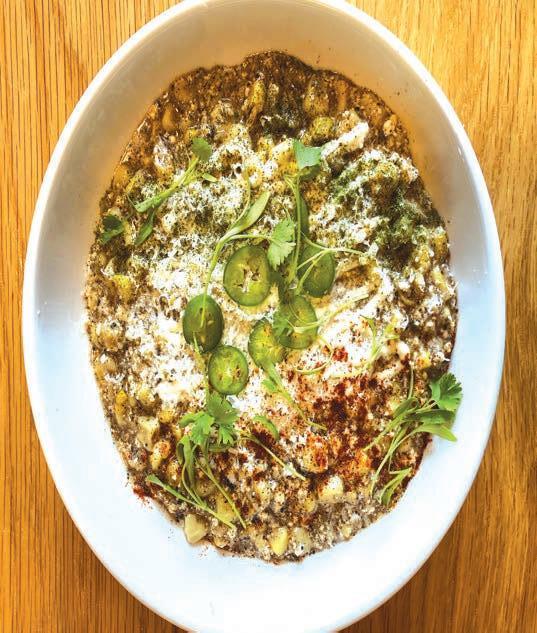
3 minute read
Elevating ELOTES
| BY ED AVIS
| Elotes is basic Mexican street food, typically roasted corn smothered in a blend of butter, grated cheese and spices. But today, some Mexican restaurant chefs have added their own twists to this classic with versions that are enticing new fans. In essence, they are elevating elotes.
The elotes on the menu at Bellota in Denver is one example. Chef Manny Barella created the dish for the restaurant, which opened in 2020 in a renovated factory building on the edge of the RiNo neighborhood. Although Barella has moved on, his elotes remain.
“There are so many Mexican restaurants that we wanted to do something to stand out when we created the menu at Bellota,” Barella says. “I worked in Italian cuisine for a long time, and I wanted our elotes to be a take on risotto with a Mexican flair.”
Barella’s version starts with the basic ingredient, white corn, but includes a number of ingredients that set it apart from what’s found at street carts in Mexico City.
“I wanted it to be re- ally creamy. When you cook risotto, you stir it a lot to release the starch in the rice,” he explains. “When we’re doing the elotes, we add a little corn starch to make it creamy, together with the cotija and lime.”
Other key ingredients include a sofrito made with shallots and garlic, thinly sliced epazote, and a touch of Mexican crema at the end.
But perhaps the most innovative ingredient is something inspired by Barella’s memories of his youth in Mexico.

“The smell of corn husks being burned in a fire is reminiscent of home for me, so we burn corn tortillas in Bellota’s open-fire oven and mix the ashes into the mayo we use for the elotes,” he explains. “If it’s done without the ashes it’s still really good, but that’s just my personal twist to the OG dish.” (Note: this ingredient is not included in the recipe found on page 55; Barella says he uses the ash from one burnt tortilla for every two cups of mayo.)
Barella says he knew his recipe was winner on the first go-round: “I did it in one take. It came out great the first time and I said, ‘OK, what’s next?’”
Chef Diana Dávila of Mi Tocaya Antojería in Chicago — a 2023 James Beard Award semifinalist — is another elotes innovator. Since her restaurant opened in 2017, she has created several versions of the dish. An early version that featured stacked, short pieces of grilled corn on the cob slathered with butter and cotija and topped with a chicharones wheel was dubbed “sculptural” by an Eater Chicago reviewer.
Davila’s later, more decadent iteration featured crema made with lobster stock, heavy whipping cream, chipotle, fresh masa and lime juice. The crema was applied via a squeeze bottle onto fresh grilled corn on the cob that had been brushed with clarified butter and sprinkled with queso fresco. An epazote chiffonade topped off the dish.
And then there was Davila’s MariaJuana Elote en Vaso — char-grilled corn off the cob mixed with CBDinfused butter, crema, cotija, lime/ chile salt, cilantro and chopped lobster tossed in lime mayo.
At Chicago’s Proxi, the restaurant’s international-fusion theme is evident in the Tempura Elotes, off-the-cob corn fried in Japanese tempura batter. The extra crunch from the carb-rich batter elevates the experience.
“The inspiration also comes from a corn fritter that the Japanese serve with udon noodles called kakiage,” said Chef Andrew Zimmerman in an article about the dish in the Michelin Guide. “In true elotes form, the dish is finished with mayonnaise, but to make it unique I use Kewpie to further the Japanese spin on the dish. It’s then garnished with Grana Padano, chile, lime and chives.”
On the streets, elotes is typically a hand-held food, either served on the cob or in a cup so customers can eat on the go. Elevated elotes is definitely a more formal dish.
“When I was kid and I was leaving school or church, there would always be someone there selling elotes in a styrofoam cup,” Barella says. “But now we sell it on nice china!”
The fine china is appropriate for food this exceptional.
“The elotes at Bellota is the proudest dish of my career,” says Barella, whose resume includes stints at Solage Calistoga in Calistoga, California; Frasca in Boulder, Colorado; and Uchi in Denver. “It’s so simple and common, but elevated.”
See the recipe of Bellota’s elotes on page 55. Ed Avis is the publisher of el Restaurante.











